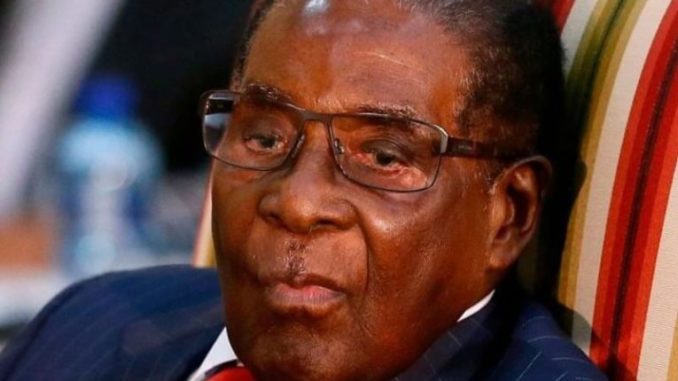
Zimbabwe President Robert Mugabe resigned on Tuesday, ending a 37-year rule that was characterised by political and economic chaos.
Emmerson Mnangagwa, whom Mr. Mugabe had sacked as Zimbabwean vice president early November for being “disloyal“, would be sworn in as president on Friday.
The momentous events leading to Mr. Mugabe’s fall began on November 15 when the country’s military chiefs took control of state television – in an apparent coup – to announce their intervention in the political crisis that had engulfed the ruling Zanu-PF.
The Chief of Army Staff, Constantino Chiwenga, strongly held that the action was not a coup, but soldiers nonetheless took over the streets in the capital, Harare.
Mr. Mugabe was also placed on house arrest by the military.
A team of negotiators from South African Development Community, SADC, was sent to Zimbabwe by South African President Jacob Zuma on November 16.
While talks were underway, Zanu-PF deposed Mr. Mugabe as its leader and elevated Mr. Mnangagwa to the position.
Mr. Mugabe, 93, had initially vowed not to step down, insisting he must complete his current five-year term which expires in 2018. He remained defiant in a nationwide address Saturday, prompting Zanu-PF to issue a deadline for him to resign.
But Mr. Mugabe, the oldest leader in the world, still defied the Monday afternoon deadline, and Zanu-PF launched impeachment proceedings against him Tuesday. It was when the proceedings began that Mr. Mugabe sent his resignation letter to the speaker of the parliament.
But Mr. Mugabe was not always the villain he has become. He was one of Africa’s most respected nationalists and played a prominent role in Zimbabwe’s independence struggle from British colonial rule.
His popularity amongst his people and respect globally was so high that he was knighted by Queen Elizabeth of England.
Here is a timeline of the key events that shaped the exploits of a man who assumed power as a revolutionary:
1963: Mr. Mugabe and other fighters for independence form the Zimbabwe African National Union to oppose white minority rule in the British colony of Rhodesia.
1964-1975: Imprisoned by colonial authorities.
1980: Independence from Britain is achieved following a brutal and relentless conflict and Mr. Mugabe becomes prime minister of a newly-named Zimbabwe.
1982: Mr. Mugabe sacks fellow independence fighter, Joshua Nkomo, who is head of the Zapu party and launches violent campaign against suspected dissidents in Matabeleland, Mr. Nkomo’s homeland. The government is accused of killing thousands of civilians.
1987: Mr. Mugabe changes the constitution and becomes president.
1994: Mr. Mugabe receives honorary British knighthood.
2000: Mr. Mugabe implements a sweeping land grab of white-owned farms, prompting Western donors to cut off aid amongst other debilitating sanctions.
2005: United States designates Zimbabwe an “outpost of tyranny”.
2008: Mr. Mugabe and opposition candidate Morgan Tsvangirai of opposition Movement for Democratic Change agree to share power after contested election that left opposition leaders brutally beaten. Britain’s Queen Elizabeth II revokes Mr. Mugabe’s honorary knighthood.
2011: Prime Minister Tsvangirai declares power-sharing a failure amid violence.
2013: Mugabe wins seventh term. MDC and other opposition parties allege election fraud. Mr. Tsvangirai proceeds on exile.
2016: #ThisFlag protest movement emerges, independence war veterans turn on Mr. Mugabe, castigating him as a dictator.
2017: Mr. Mugabe begins campaigning for 2018 elections.
November 6: Mugabe fires Mr. Mnangagwa in an apparent bid to make his wife, Grace, the vice president.
November 14: Mr. Chiwenga threatens military intervention if Mr. Mugabe fails to resolve the crisis in Zanu-PF in a way that those who didn’t participate in the war of independence were kept from assuming power. This appeared a clear rebuke of Mrs. Mugabe and strong opposition towards her leadership by the military chiefs. There are fears that Mr. Mugabe wants his wife to succeed him.
November 15: Army takes over state television and announces it has Mr. Mugabe and his wife in custody; but denies its action constitutes a coup.
November 18: Thousands of Zimbabweans march against Mr. Mugabe in Harare, Bulawayo and other parts of Zimbabwe to demand his ouster.
November 19: Zanu-PF Central Committee tells Mr. Mugabe to resign as president by noon November 20 or face impeachment. He addresses the nation but does not step aside as widely anticipated.
November 22: The Zimbabwe state-run broadcaster announces that Mr. Mnangagwa would be sworn in as president on November 24.
END

Be the first to comment